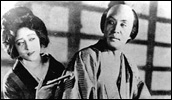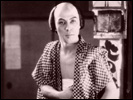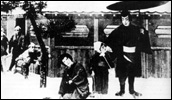Jirokichi the Rat
- Year
- 1931
- Original title
- Oatsurae Jirokichi Koshi
- Japanese title
- 御誂次郎吉格子
- Director
- Cast
- Running time
- 63 minutes
- Published
- 9 March 2009



by Roger Macy
The two earliest films in the 'Japón en Negro' season at San Sebastian in 2008 were by Daisuke Ito, arguably the most admired director of the generation before Ozu and Mizoguchi. Jirokichi the Rat was surprisingly full of oblique angles, innovative action photography, and what we might call today 'attitude'. I just wished that I could have given it more enlightened attention. My notes of the time say 'Oh, for a benshi'.
So, it was a delightful surprise to find that the seventh, and latest Talking Silents DVD from Japan's Digital Meme entirely answered my prayers. The DVD's opening menu has an 'English' option clearly shown. Selecting this takes you to a page where, besides the expected options to play Jirokichi, you can even choose your benshi. A benshi was, as many Midnight Eye readers will be aware, the narrator for silent films. If you were in Tokyo in 1931 and thinking about where to go to the movies, the figures show that you would probably pay more attention to who the benshi was than which film he or she was explaining. There's a considerable literature about them but opportunities to actually hear a benshi in the west are extremely limited (Nippon Connection in Frankfurt manages one each year), so the Talking Silents collection is valuable not just for the restored early films they contain, but also for the integrated experience they present.
Midori Sawato, the featured benshi on the disc, has been suggested for Living National Treasure (although whether the rules for this honour include narrators, I could not say). Sawato has to construct the story from the remaining film (although Jirokichi is unusually complete), be the narrator, act all the voices of the silent stars, add sound effects, and prompt the musicians. The opportunities for a benshi to get it wrong are limitless, so its success is a true work of art. For Jirokichi, Sawato transformed my experience beyond all expectation. Ito's weaving narrative became clear, the actors I was looking at improved miraculously, and the film gained real pace.
The pace of the film on this DVD depends on two particular decisions. Since the benshi's narrative is so integrated with the film, a considerable portion of explanatory titling can be omitted. This immediately clears away the cerebral task I had at San Sebastian of finding meaning from a clatter of Rosetta stones in three languages. With the clutter removed, the screen beckons as something that is showing, not telling, and Sawato approaches the art of vocal narrative with this counterpoint in mind.
For the other quickening of pace, I need to get a little technical. Digital Meme have decided to record the DVD at a projection rate of 24 frames a second, something they are clear about on the packaging. This was the standard speed of projection in the west from early in the last century, but Japan used slower rates for many years. Jirokichi's National Film Centre print was projected in San Sebastian at, I believe, 20 frames per second, taking 79 minutes to project as opposed to 61 minutes on the DVD - a substantial difference, and this excludes the added down-time at San Sebastian for reel-changes (as the NFC would not allow its precious prints to be mounted on a platter). The benshi narrative is completely constructed around this faster running time. The first visual effect is that the image quality was greatly improved upon that of the NFC print. Some of this will be due to digital restoration over optimum projection settings (the constant reel changes would have done nothing for consistency at San Sebastian), but the faster image refreshment rate on the eye makes a real difference to the vividness of the screen image.
The warping of time has surprisingly little effect upon most scenes, perhaps because we are used to a tighter modern time-scale. The only marked problem is in the fight scenes. These were the strongest parts of the film at San Sebastian, but tipped over into being a little frantic on the DVD. Many of these shots would originally have been under-cranked during shooting, so the extra dose of acceleration in these parts was a step too far.
But what makes the film so much more pleasurable on the DVD is the vividness of the close-ups, as the actors - and particularly Naoe Hashimi - are seen to react to the dialogue. So Sawato has effectively become the live editor of the film, re-creating its immediacy and counterpoint. Superbly consistent and unintrusive 'voice-colouring' mean that the implications of the characters' conflicting motives seemed to be intuitively understood. You no longer need to keep setting an intentional map-out of the titles to read the emotional import of the dialogue.
So, what kind of film is Jirokichi the Rat? At the time, it would have seemed like a daringly modern chanbara, or sword-fight film, even though hardly any of the action revolves around samurai and no gangs are mentioned. Jirokichi was an extremely well-known character, much developed through years of narrations into a sort of urban Robin Hood figure from the 19th century Edo period - a chivalrous burglar, as the title has been translated. But Jirokichi's chivalry has feet of clay and a roving eye that can tire of a generously human lover astonishingly quickly. Jirokichi is played by a star at the peak of his career, Denjiro Okochi, and the film allows him to display the art of his fight-skills and of his straight acting, contrasting these with his slapstick, clowning side, when he briefly plays the role of a Jirokichi look-a-like.
But the film was brought to San Sebastian as a 'police' film, which is interesting, as the only character of the forces of law and order who is foregrounded with a name, is the villain of the piece, whom Jirokichi sets out to slay in the course of his duty. Only by adapting a traditional story - one that mocks the Tokugawa regime - could Ito have got away with such a subversive act, even in 1931, just before the crackdown in Japan. Of course, if the police were always portrayed as efficient and competent, there would be no policiers worth watching, but an alternative title to the 'Japón en Negro' season could have been 'The forty three paths of police incompetence'. Even so, this film possibly caps them all, since the police are led by a murderer who sells his sister. The massed police never manage to arrest Jirokichi on screen, despite combining finally in a stunningly choreographed night scene. Ito puts up a perfunctory title at the end to report a much later capture in Edo. This barely seems to pass the requirement of films of that time that crime could never pay. Perhaps the most anti-authoritarian comment is given at the start to Naoe Hashimi's geisha character, Osen. She watches as a strong police detachment make a 'definite' identification of Jirokichi based on an eye-patch, then fail to detain their suspect in the confines of a small boat. She leans nonchalantly to obscure her fellow traveller, whom she has spotted hiding, and remarks 'The police don't miss a thing'.
Osen and Jirokichi become star-crossed lovers on the riverboat plying its way from Kyoto to Osaka. Jirokichi has had to flee from Edo and the mix of Edo and Osaka characters allows benshi Sawato to have great fun with Kansai and Kanto dialects and further helps her differentiation of voices. Whatever genre it belongs to, it's a beautiful yarn that manages to encompass an astonishing amount of attitude.
[On the DVD, Sawato also narrates two short surviving episodes of Yaji and Kita by Tomiyasu Ikeda from 1927 and 1928, and there is an interesting short talk by Tadao Sato on this comedy duo. For viewing Jirokichi, there is even a choice of subtitles. These, however, turn out to be an identical translation with subtly varied spotting by two different, credited, benshi. The translation itself is not credited, but should have been - it's much better than its anonymity promised. Since the English texts are identical, it must be fair to guess that both benshi worked from the same script, handed down from their sensei, Shunsui Matsuda.]